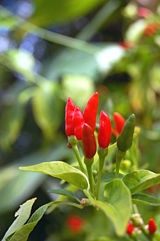- Bird's eye chili
-
For a similar variety of Capsicum frutescens better known as peri-peri, see African birdseye.
Bird's Eye Heat  Very hot
Very hotScoville rating 50,000–100,000 Bird's eye chili (Thai: พริกขี้หนู, RTGS: phrik khi nu, IPA: [pʰrík kʰîː nǔː], literal: Rat dropping chili; Indonesian: Cabai rawit; Tagalog: siling labuyo) is a chili pepper of the species Capsicum frutescens L. in the family Solanaceae, commonly found in South-east Asia. It can also be found in India, mainly Kerala, where it is used in traditional dishes of the Kerala cuisine (pronounced in Malayalam as kanthari mulagu Malayalam: കാന്താരി മുളക്). This species (known as කොච්චි (kochchi) in sinhalese) is also found in rural areas of Sri Lanka, where it is used as a substitute for green chillies. It is also a main ingredient in kochchi sambal, a salad made using freshly scraped coconut ground with thai chillies and seasoned with salt and lime juice.
The term Bird's eye chili is also used for the North American Chiltepin pepper, both due to their small round shape and because they're widely spread by birds.
Contents
Cultivars
Description
The bird's eye chili plant is a perennial with small, tapering fruits, often 2-3, at a node. The fruits of most varieties are red, some are yellow, purple or black. The fruits are very pungent. The flowers are greenish white or yellowish white.[1]
Taxonomically, it has long been thought that the bird's eye chili belongs to Capsicum frutescens L.,[2][3][3] but there are now some who list the bird's eye chili as belonging to Capsicum chinense.[4]
The bird's eye chili is small but packs quite a lot of heat. It measures around 50,000-100,000 Scoville units which is at the lower end of the range for the hotter Habanero chili.
Characteristics of the Birds Eye Chili plant[5]
 Bird's eye chilies growing wild on Saipan.
Bird's eye chilies growing wild on Saipan.
- Plant height - up to 2meters
- Stem color - Green
- Leaf color - Green
- Leaf size - 3–8 cm by 2–4 cm
- Fruit color at maturity - green, orange and red
- Fruit shape - conical
- Fruit length - 2–3 cm
- Fruit width at shoulder - .5 cm
- Fruit weight - 2-3 grams
- Fruit surface - smooth
- Seed color - Light tan
- Seeds per chili - 10-20
Origins
All chilies found around the world today have their origins in Central America and South America. Chilies were spread by the Spanish and the Portuguese in their quest to build a global empire and are still grown in their former colonies in Africa and Asia. The chili varieties found in Southeast Asia today were imported and cultivated by Spanish and the Portuguese colonists and traders.
Common names
The chilies may also be referred to as cili padi (cili pronounced "chili") in parts of Malaysia because their small size reminds people of the small grained rice eaten as a staple in the region. In the northern parts of Malaysia, this chili is known as cabai burung or bird chili as birds like to eat this variety of chili.
As well as the Malay word, Thai chilies can also be referred to as cabe rawit (Indonesian), lombok rawit (Javanese), cengis (Banyumasan language), cengek (Sundanese), phrik khi nu (พริกขี้หนู, Thai), Thai hot, Thai dragon (due to its resemblance to claws), siling labuyo (Filipino), ladâ, and boonie pepper (the Anglicized name).
Uses
Cooking
 Phrik nam pla - bird's eye chili with fish sauce and lime juice - is served with nearly every Thai meal
Phrik nam pla - bird's eye chili with fish sauce and lime juice - is served with nearly every Thai meal
The fruit of the bird's eye chili is popularly used as a spice in South-east Asian cuisine. It is what gives local dishes, such as the Filipino bicol express, their fiery zing.[6] The chilies can also be used to flavor vinegar. The leaves are also edible and can be eaten as a vegetable,[7] for instance in the Filipino dish tinola.
Ornamentals
The more decorative, but slightly less pungent variety, sometimes known as Thai Ornamental, has peppers that point upward on the plant, and go from green to yellow, orange, and then red. It is the basis for the hybrid Numex twilight, essentially the same but less pungent and starting with purple fruit, creating a rainbow effect, and among the group of Capsicum annuum. These peppers can grow wild in places like Saipan and Guam. The Chinese in Southeast Asia call this pepper 'the chili that points to the sky'.
Medicine
In medicine, the bird's eye chili was traditionally used to ease arthritis and rheumatism, and also as a cure for dyspepsia, flatulence, and toothache.[7]
It can also be used as a natural insect repellent or pesticide when mixed with water.[8][9]
See also
References
- ^ Hot Pepper
- ^ Capsicum Frutescens Linn. Sileng-Labuyo
- ^ a b Chile Varieties Database
- ^ DeWitt, Dave and Bosland, Paul W.: Peppers of the World: An Identification Guide, page 63. Ten Speed Press. 1996. ISBN 0898158400. Retrieved 2009-10-25.
- ^ Growing Chili - Bird's Eye Chili
- ^ Recipe for Bicol Express. Retrieved 2010-01-05.
- ^ a b Nagpala, Ellaine Grace. (2007). A fresh look at siling labuyo. BAR Chronicle 8(10). Retrieved 2009-10-22.
- ^ Aguilar, Ephraim. (2007-5-31). School teaches love for environment. Philippine Daily Inquirer. Retrieved 2009-10-22.
- ^ Organic Farming
Capsicum cultivars C. annuum Aleppo · Anaheim · Ancho · Banana pepper · Bell pepper · Cascabel · Cayenne · Chilaca · Chiltepin · Cubanelle · De árbol · Dundicut · Fresno · Guajillo · Hungarian wax · Italian sweet · Jalapeño · Mirasol · Macho · Mulato · New Mexico (Anaheim) · Paprika · Pasilla · Peperoncini · Peter · Piquín · Pimento · Poblano · Puya · Serrano · Shishito · Tien TsinC. chinense Adjuma · Ají Limo · Ají dulce · Datil · Fatalii · Habanero · Hainan Yellow Lantern Chili · Madame Jeanette · Naga Jolokia · Red Savina Habanero · Scotch bonnetC. frutescens C baccatum C. pubescens Categories:- Spices
- Chili peppers
- Lao ingredients
- Thai ingredients
- Malaysian ingredients
- Indonesian ingredients
- Philippine ingredients
- Singaporean ingredients
- Indian ingredients
Wikimedia Foundation. 2010.

